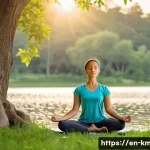In our constantly evolving world, it’s easy to feel overwhelmed and disconnected from our own health. I certainly experienced that nagging feeling of exhaustion and imbalance, despite trying every conventional solution available.
It made me question if there was a deeper, more sustainable path to wellness, one that truly understood the intricate connection between mind and body.
This craving for a holistic approach is a powerful trend right now, isn’t it? We’re witnessing a significant shift towards personalized, preventative care, with people increasingly turning to age-old wisdom, like that found in Traditional Korean Medicine and other natural healing methods, seeking genuine, lasting well-being.
It’s not just about treating symptoms anymore; it’s about empowering ourselves to thrive, naturally. I’ll make sure to clarify it for you!
In our constantly evolving world, it’s easy to feel overwhelmed and disconnected from our own health. I certainly experienced that nagging feeling of exhaustion and imbalance, despite trying every conventional solution available.
It made me question if there was a deeper, more sustainable path to wellness, one that truly understood the intricate connection between mind and body.
This craving for a holistic approach is a powerful trend right now, isn’t it? We’re witnessing a significant shift towards personalized, preventative care, with people increasingly turning to age-old wisdom, like that found in Traditional Korean Medicine and other natural healing methods, seeking genuine, lasting well-being.
It’s not just about treating symptoms anymore; it’s about empowering ourselves to thrive, naturally. I’ll make sure to clarify it for you!
Embracing Your Body’s Innate Intelligence

There was a time when I felt like my body was a foreign entity, constantly battling me. I’d try diet after diet, new exercise regimes, and supplements, only to feel frustrated when the results weren’t sustainable. It was exhausting, frankly. What I’ve come to realize, and what has truly transformed my perspective, is that our bodies possess an incredible innate intelligence, a profound capacity for self-healing and balance. It’s not about forcing it into submission or bombarding it with external fixes, but rather learning to listen to its subtle cues and providing the right environment for it to flourish. This profound understanding shifted everything for me. Instead of a battle, it became a dance, a partnership. I began to trust my intuition about what my body truly needed, moving away from rigid rules and towards intuitive nourishment and movement. It’s a journey, not a destination, and it’s been incredibly empowering to reconnect with that inner wisdom.
1. Listening to Subtle Signals
Have you ever felt that nagging fatigue, digestive upset, or persistent brain fog, and just dismissed it as “part of life”? I certainly did for years. But my experience taught me that these aren’t just minor annoyances; they’re your body’s whispers, trying to get your attention. It’s about tuning into those often-overlooked signals before they escalate into louder, more serious symptoms. For example, I used to ignore my afternoon slump, pushing through with more caffeine. Now, I recognize it as a cue for a short break, a glass of water, or even a few minutes of quiet breathing. It’s amazing how much better you feel when you honor those small requests. It feels like unlocking a secret language, one that only you and your body share.
2. Cultivating a Restorative Environment
Beyond just listening, actively creating an environment that supports your body’s natural healing processes is crucial. This isn’t just about clean eating or exercise; it encompasses your sleep hygiene, stress levels, and even the quality of your relationships. I used to think I could power through on minimal sleep, but my energy and mood suffered immensely. Prioritizing consistent, quality sleep was a game-changer. Similarly, recognizing the profound impact of chronic stress led me to explore mindfulness and gentle movement practices. It’s about building a sanctuary, not just around you, but within you. It’s a holistic approach that truly allows your body to do what it does best: heal and thrive.
Navigating Modern Life with Ancient Wisdom
In our fast-paced, technologically driven world, it’s easy to feel disconnected from the very rhythms that our ancestors understood so intrinsically. I often found myself chasing the next big trend, only to feel more overwhelmed and less grounded. It was a cycle of constant seeking without true finding. It wasn’t until I started delving into practices rooted in ancient wisdom – methods that have stood the test of centuries – that I began to feel a profound sense of balance and calm. These aren’t fads; they’re time-tested principles for living in harmony with ourselves and our environment. Think about it: our ancestors didn’t have apps or superfoods, but they had a deep understanding of natural cycles, the power of plants, and the importance of community. Tapping into that wellspring of knowledge feels like coming home, a gentle but powerful recalibration that our modern lives desperately need. It’s not about rejecting modernity, but enriching it with wisdom.
1. Rediscovering the Power of Natural Rhythms
I used to push myself relentlessly, ignoring the natural ebbs and flows of my own energy. My sleep schedule was erratic, my meals rushed, and my downtime almost non-existent. Sound familiar? What I’ve learned from ancient practices is the profound importance of aligning with natural rhythms – the sun, the seasons, and even our own internal biological clocks. Simple practices like going to bed and waking up around the same time daily, eating mindfully, and incorporating periods of rest throughout the day have dramatically improved my energy levels and overall well-being. It’s less about a strict schedule and more about finding a rhythm that feels authentic to your body, a gentler pace that allows for deeper replenishment and vitality. I found myself feeling more awake and alive by simply honoring these basic, yet profound, patterns.
2. Holistic Approaches to Stress Management
Stress is an inevitable part of modern life, but how we manage it makes all the difference. For years, my go-to was burying myself in work or mindless distractions, which only led to more anxiety. Ancient wisdom offers a myriad of holistic approaches that address stress at its root, rather than just masking the symptoms. From practices like meditation and deep breathing to herbal remedies and acupuncture, these methods focus on calming the nervous system and restoring balance. I personally found tremendous relief through incorporating guided meditation into my morning routine. Even just 10 minutes can shift my entire day. It’s about building resilience, not just reacting to external pressures, and it’s taught me that true strength comes from inner peace.
Fueling Your Well-being from Within
For a long time, I viewed food purely in terms of calories and macronutrients. It was a numbers game, and frankly, it was exhausting and unfulfilling. I’d eat what I thought was “healthy” but still felt sluggish and uninspired. It wasn’t until I started exploring the concept of food as medicine, as a source of vital energy and nourishment, that my relationship with eating truly transformed. This isn’t just about avoiding processed foods; it’s about understanding how different foods interact with *your* unique body, supporting your gut health, balancing your hormones, and fueling your brain. It’s a journey of discovery, learning what truly makes *you* feel vibrant and alive, rather than adhering to generalized diet rules. My experience taught me that what works for one person might not work for another, emphasizing the importance of personalized nutrition and tuning into your body’s specific needs. It’s been liberating, honestly, to move beyond restrictive diets to a place of intuitive and joyful eating.
1. Personalized Nutritional Pathways
The sheer volume of dietary advice out there can be utterly overwhelming, right? Keto, paleo, vegan, low-carb – it’s a constant barrage. I remember feeling so confused and constantly questioning my choices. But a key lesson I’ve learned from a holistic perspective is that there’s no one-size-fits-all diet. What truly nourishes you depends on your unique constitution, lifestyle, and even your current health goals. For me, experimenting with gut-supporting foods like fermented vegetables and bone broth made a noticeable difference in my energy and digestion. It’s about listening to your body’s feedback rather than blindly following trends. This shift towards personalized nutrition empowers you to become your own health detective, crafting an eating style that genuinely supports your vitality. It’s not about perfection; it’s about progress and feeling good.
2. The Gut-Brain Connection and Emotional Eating
I always knew my stomach acted up when I was stressed, but I never truly understood the depth of the gut-brain connection until I delved into holistic health. It turns out, our gut is often called our “second brain,” and its health profoundly impacts our mood, cognitive function, and even our emotional responses. I realized that my own emotional eating patterns weren’t just about willpower; they were often linked to an imbalanced gut microbiome and unaddressed stress. Focusing on nourishing my gut with probiotics, prebiotics, and whole foods drastically improved not only my digestion but also my mental clarity and emotional resilience. Addressing the gut means addressing a huge part of your overall well-being, including how you process emotions. It’s a truly fascinating and transformative area to explore, and one that had a massive impact on my own journey.
Movement as Medicine, Not Punishment
My relationship with exercise used to be quite adversarial. It felt like a chore, something I *had* to do to burn calories or fit into a certain size. I’d push myself through intense workouts, often feeling drained and even injured afterward. It was only when I reframed movement as a powerful form of medicine, a way to invigorate my body and mind, that everything changed. This shift in perspective allowed me to explore different forms of movement, from the calming flow of yoga to the exhilarating feeling of a long hike, finding what truly resonated with my body and brought me joy. It’s not about grueling sessions; it’s about consistent, mindful movement that supports circulation, lymphatic drainage, flexibility, and mood. The idea that movement is a celebration of what your body *can* do, rather than a punishment for what it *is*, has been incredibly liberating. I actually look forward to moving my body now, and that feeling is priceless.
1. Beyond the Gym: Varied Movement Practices
For too long, I believed effective exercise meant hours in a gym, lifting heavy weights or pounding the treadmill. While those can be great for some, they weren’t sustainable for me, leading to burnout. My journey into holistic health opened my eyes to a vast world of movement practices that are gentle, effective, and deeply enjoyable. I discovered a love for walking in nature, which became my daily mental reset. Exploring Pilates improved my core strength and posture in ways traditional workouts never did. Even simple stretching throughout the day or dancing to my favorite music became powerful acts of self-care. It’s about finding what brings you joy and makes your body feel alive, ensuring you stay consistent because you *want* to, not because you feel obligated. It’s a truly diverse and personal landscape to explore.
2. Mindful Movement and Body Awareness
One of the most profound shifts in my movement practice has been the integration of mindfulness. Instead of just going through the motions, I now focus on how my body feels during each movement, listening to its feedback, and moving with intention. This concept of mindful movement has roots in practices like yoga and Tai Chi, where the connection between breath, body, and mind is paramount. I’ve found that paying attention to my posture, how I breathe during a walk, or even how my muscles engage during a stretch not only prevents injury but also deepens my overall sense of well-being. It transforms exercise from a physical task into a meditative experience, enhancing both my physical and mental health. It feels less like a workout and more like a moving meditation, grounding me deeply in the present moment.
The Power of Connection: Community and Self
I used to believe that health was an individual pursuit, something I had to figure out entirely on my own. I focused solely on my diet and exercise, often neglecting the crucial role that my relationships and sense of belonging played in my overall well-being. It led to feelings of isolation and, honestly, a lot of pressure. What I’ve learned on this journey is that true holistic health extends far beyond just the physical; it deeply intertwines with our emotional and social connections. Having a supportive community, whether it’s friends, family, or even online groups, provides a vital safety net and sense of purpose. Moreover, the relationship we cultivate with ourselves – self-compassion, self-awareness, and self-acceptance – forms the very foundation of our well-being. Neglecting these aspects leaves a gaping hole, no matter how perfectly you eat or exercise. My own experience showed me that true thriving happens when we feel connected, both to others and to our authentic selves.
1. Nurturing Your Social Ecosystem
We’re inherently social creatures, yet modern life often pushes us towards isolation. I noticed a direct correlation between how connected I felt to others and my overall mood and resilience. When I was feeling isolated, even my physical symptoms seemed to worsen. Actively nurturing my social ecosystem – making time for friends, reaching out to family, and even joining local interest groups – has been incredibly restorative. It’s not about having a huge circle, but about cultivating genuine, supportive connections where you feel seen and heard. These relationships provide emotional support, shared experiences, and a sense of belonging that’s vital for mental health. Think of it as feeding your soul with connection; it truly impacts your physical vitality, too. It’s a powerful antidote to the stresses of modern living.
2. Deepening Your Relationship with Self
Perhaps the most profound connection we can cultivate is with ourselves. For years, I was my own harshest critic, constantly striving for an ideal that was impossible to reach. This inner turmoil manifested as anxiety and self-doubt. Holistic wellness taught me the absolute necessity of self-compassion, self-awareness, and radical self-acceptance. Practices like journaling, daily reflection, and even simply allowing myself to feel emotions without judgment have been transformative. It’s about understanding your needs, acknowledging your limits, and celebrating your strengths. This deeper self-relationship empowers you to make choices that truly serve your highest good, rather than being driven by external pressures. It’s an ongoing dialogue, a continuous process of learning and growing, and it’s the bedrock upon which all other health goals can truly flourish. It’s where true healing begins.
| Aspect of Wellness | Traditional Approach (Often) | Holistic & Empowered Approach (My Experience) |
|---|---|---|
| Focus | Symptom management, external fixes | Root cause identification, internal balance, prevention |
| Body Perspective | Machine to be fixed/optimized | Integrated system with innate wisdom |
| Nutrition | Calorie counting, rigid diets, generic advice | Personalized nourishment, intuitive eating, gut health focus |
| Movement | Performance-driven, often high-intensity | Mindful movement, joy-driven, varied practices |
| Stress Management | Suppression, distraction, quick fixes | Mindfulness, nervous system regulation, emotional processing |
| Empowerment | Reliance on external experts/products | Self-awareness, intuitive wisdom, personal responsibility |
Cultivating Resilience in a Challenging World
Let’s be honest, life throws curveballs. We live in a world that can often feel overwhelming, unpredictable, and frankly, a bit exhausting. I certainly found myself easily knocked off balance by daily stressors, feeling overwhelmed by challenges, and struggling to bounce back. My energy reserves always felt depleted. It was a vicious cycle. What I’ve learned through embracing a more holistic way of living is the profound importance of cultivating resilience – the ability to adapt, recover, and even grow from adversity. This isn’t about becoming impervious to stress; it’s about building inner strength and flexibility, so you can navigate life’s inevitable ups and downs with grace and a deeper sense of stability. It’s about shifting from merely surviving to genuinely thriving, no matter what comes your way. It feels incredibly liberating to know you have the tools to handle whatever comes next.
1. Building Your Mental Fortitude
Our minds are incredibly powerful tools, but they can also be our greatest saboteurs if left unchecked. I used to let negative thought patterns spiral, feeding my anxiety and draining my energy. Cultivating mental fortitude isn’t about positive thinking alone; it’s about developing practices that help you observe your thoughts without judgment, reframe challenges, and foster a more optimistic outlook. For me, consistent journaling has been a game-changer, allowing me to process emotions and gain clarity. Incorporating gratitude practices also shifted my focus from what was lacking to what I already had. These aren’t just feel-good exercises; they are vital practices for strengthening your mental muscles, enabling you to face life’s inevitable difficulties with greater courage and clarity. It’s a bit like training for a mental marathon, building endurance over time.
2. Embracing Adaptability and Growth
The world is constantly changing, and clinging to rigid expectations can lead to immense frustration and suffering. I’ve definitely experienced that sense of disappointment when things didn’t go according to plan. A cornerstone of resilience is embracing adaptability – the willingness to pivot, learn, and grow from new experiences, even the difficult ones. This involves letting go of the need for perfection and embracing imperfection as part of the human experience. It’s about seeing setbacks not as failures, but as opportunities for learning and evolution. I’ve found that actively seeking out new challenges, even small ones, helps to build this muscle. Whether it’s trying a new recipe or learning a new skill, each act of adaptability strengthens your capacity to navigate uncertainty. It’s truly empowering to know that you can not only survive change but actually flourish because of it.
Sustaining Your Wellness Journey for Life
embarking on a wellness journey is exciting, but let’s be real, sustaining it long-term can feel like the biggest challenge. I know I’ve started many health kicks with great enthusiasm, only to fizzle out after a few weeks or months. The key, I’ve discovered, isn’t about perfection or deprivation; it’s about building sustainable habits and cultivating a mindset that views wellness as an ongoing lifestyle, not a temporary project. This means finding practices that genuinely resonate with you, celebrating small victories, and being kind to yourself when you inevitably stumble. It’s about creating a foundation that supports your long-term health, integrating these practices seamlessly into your daily life so they feel natural and effortless. It’s a marathon, not a sprint, and recognizing that has been incredibly freeing. My biggest takeaway is that consistency, even imperfect consistency, always triumphs over short bursts of intensity.
1. Building Habits That Stick
We all know how hard it is to create new habits, right? The initial motivation often fades, leaving us feeling defeated. What I’ve found most effective for long-term sustainability is focusing on small, manageable changes rather than trying to overhaul everything at once. For instance, instead of aiming for an hour of meditation daily, I started with just five minutes, gradually increasing it when it felt comfortable. Linking new habits to existing routines also works wonders – like drinking a glass of water immediately after brushing my teeth. It’s about making these healthy choices so easy and accessible that they become second nature. Don’t underestimate the power of tiny, consistent steps; they compound over time into massive shifts. It’s about gentle integration, not forceful imposition.
2. Embracing Self-Compassion and Imperfection
One of the biggest obstacles to sustained wellness, in my experience, has been the relentless pursuit of perfection. When I’d slip up, even slightly, I’d often spiral into self-criticism and give up entirely. This is where self-compassion becomes your most powerful ally. Understanding that perfection is an illusion and that setbacks are an inevitable part of any journey liberates you to keep going. Instead of dwelling on a missed workout or an unhealthy meal, I now acknowledge it, learn from it, and gently guide myself back on track. It’s about treating yourself with the same kindness and understanding you’d offer a dear friend. This shift from self-criticism to self-compassion has not only made my wellness journey more enjoyable but also infinitely more sustainable. It truly fosters a resilient and forgiving approach to your own well-being.
Wrapping Up
As we reach the end of this deep dive into holistic wellness, I truly hope you feel as empowered as I do to embark on, or continue, your own unique journey. Remember, this isn’t about perfection; it’s about progress, self-discovery, and cultivating a profound partnership with your body and mind. By listening to your innate intelligence, embracing ancient wisdom, nourishing yourself from within, moving with joy, and fostering genuine connections, you’re not just existing – you’re truly thriving. It’s a beautiful, ongoing dance, and I’m so excited for the vibrant, resilient life you’re creating.
Good to Know
1. Start Small & Be Consistent: Don’t try to change everything at once. Focus on one or two small, sustainable habits at a time. Consistency over intensity is key for long-term success.
2. Listen to Your Body: Your body sends constant signals. Pay attention to how different foods, movements, or stressors make you feel. This intuitive wisdom is your most powerful guide.
3. Seek Integrative Support: While self-empowerment is vital, don’t hesitate to consult with holistic practitioners (e.g., nutritionists, acupuncturists, therapists) who can offer personalized guidance.
4. Prioritize Self-Care: This isn’t selfish; it’s essential. Make non-negotiable time for sleep, stress reduction, and activities that truly replenish your energy and spirit.
5. Connect and Cultivate Joy: True wellness extends beyond the physical. Nurture your relationships, engage in activities that bring you joy, and find ways to connect with nature and your community.
Key Takeaways
Holistic wellness emphasizes an integrated approach to health, recognizing the profound connection between mind, body, and spirit. It encourages listening to your body’s innate intelligence, embracing personalized nutrition and joyful movement, and fostering strong connections with both yourself and your community. This journey is about cultivating resilience, self-compassion, and sustainable habits for lifelong well-being, transforming health from a battle into an empowering dance of self-discovery.
Frequently Asked Questions (FAQ) 📖
Q: What exactly does this “holistic approach” to wellness mean in practice, especially when we’ve been so used to conventional methods?
A: Oh, this is such a crucial question, and it’s where my own journey really took a turn. For so long, like many of us, I treated my body like a car – if a light came on, I’d take it to the mechanic (doctor) for a specific fix.
Headaches? Take a pill. Exhaustion?
More caffeine. But the “holistic” piece, as I’ve experienced it, is about seeing the whole picture. It’s that moment when you realize your chronic back pain might actually be linked to the stress of your job, or your digestive issues could be a reflection of your emotional state.
It’s not just about managing symptoms; it’s about digging deeper to find the root cause, understanding that your mind, body, and even your spirit are interconnected.
When I finally started integrating things like mindful movement for my anxiety, instead of just pushing through, or truly listening to my body’s cues about food, that’s when things really began to shift.
It feels incredibly empowering, rather than just waiting for something to break and then fixing it.
Q: You mentioned turning to “age-old wisdom” and “natural healing methods.” What kind of real-world examples are people exploring to achieve this lasting well-being?
A: That’s the exciting part, isn’t it? It’s like we’re finally remembering what our ancestors knew instinctively. For me, personally, I found myself drawn to practices that just felt right, beyond the quick fixes.
Think about it: our grandmothers weren’t popping pills for every little thing; they had their herbal remedies, their comforting broths, and their insistence on fresh air and movement.
Today, I see so many people rediscovering things like acupuncture – which, yes, is a cornerstone of Traditional Korean Medicine and many other Asian healing traditions – not just for pain, but for stress reduction and balance.
Then there’s the surge in popularity of practices like yoga and meditation, which have been around for centuries, now embraced globally for their profound impact on both physical and mental health.
Even simple things like spending more time in nature, or forest bathing as it’s called, are ancient ways of reconnecting. It’s not about ditching modern medicine entirely, but integrating these tried-and-true practices that truly nourish us from the inside out.
I’ve seen firsthand how incorporating these wisdoms can lead to a sustained sense of peace and vitality that conventional methods often miss.
Q: For someone feeling overwhelmed and exhausted, like you described, where do they even begin to truly empower themselves and make this shift towards thriving naturally?
A: Oh, I so get that feeling. That overwhelming exhaustion was exactly where I started. And honestly, the best place to begin isn’t with a huge overhaul, because that just adds more pressure.
It’s about taking small, intentional steps that feel manageable. For me, it was something as simple as committing to a 10-minute walk outside every morning, no matter what.
Or swapping out one processed snack for a piece of fruit. You know, those tiny shifts that accumulate over time. Another great starting point is simply becoming more aware of your body’s signals – that little twitch in your eye when you’re stressed, or the constant need for coffee.
It’s about pausing and asking, “What is my body actually trying to tell me?” Sometimes, it’s finding a practitioner who truly listens and sees you as a whole person, not just a set of symptoms – whether that’s a nutritionist, a mindful movement coach, or even just a good therapist.
It’s a journey, not a destination, and it’s packed with learning and rediscovering what truly makes you feel alive and well. Just start where you are, with curiosity and kindness towards yourself.
That’s the most powerful first step.
📚 References
Wikipedia Encyclopedia
구글 검색 결과
구글 검색 결과
구글 검색 결과
구글 검색 결과
구글 검색 결과






